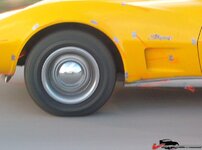JPhil
Huh?
Well this brings up something I noticed when I pulled the hood to pull the motor. On my radiator, all the fuzz & leaves were in a shallow V on the top third of the radiator. Indicating to me that that is where the airflow is. Looking at the big-ass vacuum tank across the frame horns ('73 model) & the lower splashguard & the headlight vacuum buckets, I could see how the airflow would be directed this way. I long ago removed the front license plate & mount and put a grill there for straight-in airflow, but those items still interrupt the airflow.
Made me wonder about a curved sheetmetal vane over the vac tank to direct more air to the lower portion of the radiator. (And a 1/8" mesh screen in front of the rad to catch leaves & etc.)
Made me wonder about a curved sheetmetal vane over the vac tank to direct more air to the lower portion of the radiator. (And a 1/8" mesh screen in front of the rad to catch leaves & etc.)
Last edited:

